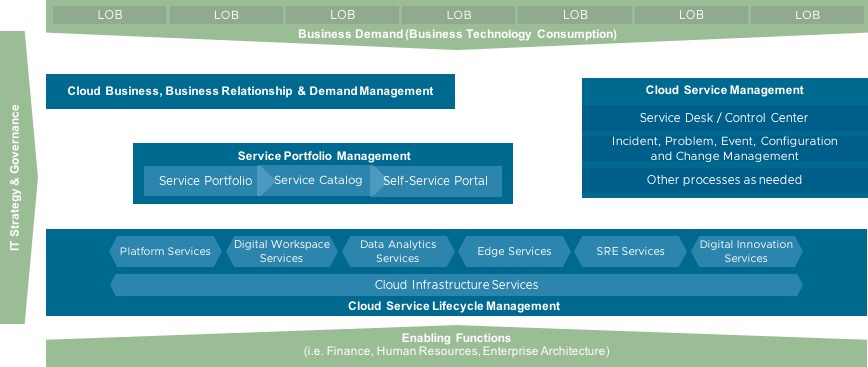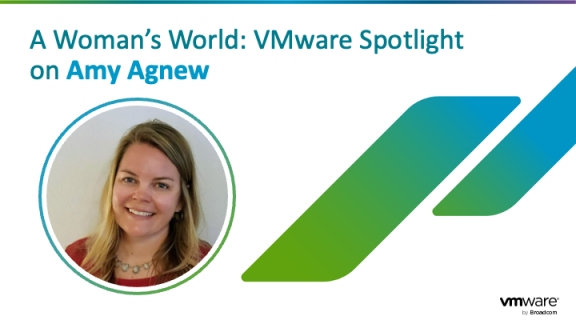Your business is ready to reap the rewards of the cloud era. But is your IT organization ready to deliver?
I recently expanded my Organizing for the Cloud white paper to incorporate customer feedback, along with VMware’s direct experience working with customers over the last couple of years. It also addresses an increasingly common set of questions we’re now getting as customers embark on their journey to more fully utilizing multi-cloud environments. The expanded content is primarily focused on describing:
- The core concept of cloud services lifecycle management teams
- A three-phase approach to implementing a Service-Oriented Cloud Organizational Model
- An approach to structuring and managing cloud services lifecycle management teams
Cloud Services Lifecycle Management Teams
VMware recommends a service-oriented approach to a customer’s cloud operating model, as shown in Figure 1. A service-oriented approach stresses direct collaboration between IT and its customers resulting in a customer-driven culture using outside-in thinking rather that IT’s traditional inside-out thinking (we know what the customer wants). IT moves from deploying technology to satisfy project requirements to delivering services that can be consumed by multiple customers typically beginning with Infrastructure Services and Platform Services but evolving to higher-order services like Digital Workspace Services and Data Analytics Services. Ultimately, IT becomes a cloud service provider/broker in its own right.

At the core of this service-oriented approach lies the concept of cloud services lifecycle management teams. Cloud services lifecycle management teams are self-sufficient, exhibit a DevOps mindset, and work in an Agile way. These teams are wholly accountable and responsible for the full lifecycle of their service(s). They are blended teams, meaning they contain the core skills and capabilities required to address the ‘plan’ (strategy to services architecture), ‘build’ (engineering), ‘deliver’ (request to fulfillment), and ‘run’ (operations) aspects of their services, as well as the critical technologies and/or cloud-based services comprising their service.
Three-Phase Approach to Implementation
As customers begin their journey to fully embrace the use of public cloud providers with an eye towards using multi-cloud environments, they are creating a Cloud Center of Excellence as a very common first step. This is a reasonable way to begin organizing for cloud because it consolidates efforts into a single team whose sole focus is: creating the cloud strategy; developing and owning the initial services offered in the cloud-based environment; onboarding cloud services; providing guidance on using cloud services; and reporting cloud usage. It also helps enable and promote the adoption of those cloud services.
A second stage in the organizing for the cloud evolution occurs as customers move past the initial, incubation phase of using cloud services to one where the cloud strategy is being more fully embraced, cloud service usage is expanding, it’s becoming more business-critical, and/or there is a desire to expand to multiple cloud service providers. This is the stage where the concept of cloud services lifecycle management teams is first introduced. At the same time, the Cloud Center of Excellence shifts to focus more on overall cloud business management and governance.
The third phase occurs as IT expands its cloud-based services to fully leverage the best capabilities amongst multiple cloud providers when building the services IT offers. This typically involves creating or “spinning off” additional teams as services begin to scale and become increasingly business-critical. These teams are typically accountable for services like, for example, cloud-based digital workspace services or perhaps cloud-based data analytics services that require subject matter expertise and their own focus beyond the team responsible for Infrastructure Services and/or Platform Services.
Structuring and Managing
A common question we get relates to structuring and managing the cloud service lifecycle management teams as they begin to expand. We have found the model used at Spotify to work quite well as a way to structure teams in this situation. As for managing these teams, the helix management model from McKinsey is described. The combination of the Spotify and helix management models is depicted in Figure 2.

While no one prescribed organizational or management model will work for every enterprise, this combination of the Spotify structure and helix management model works well to enable the culture and intent of service-oriented cloud organizational models and cloud services lifecycle management teams.
Likely, this will not be the last time I update the Organizing for the Cloud white paper. The ubiquity and flexibility of service delivery in the cloud environment continues to evolve, dramatically impacting the very nature of IT, how it interacts with its customers, and the impact it can have on the digital business. The “only constant is change,” and Organizing for the Cloud will continue to evolve based on our experience working with customers as they undergo their transformations.
About the Author
Kevin Lees is the field Chief Technologist for IT Operations Transformation at VMware, focused on how customers optimize the way they operate VMware-supported environments and solutions. Kevin serves as an advisor to global customer senior executives for their IT operations transformation initiatives and is a member of VMware’s Global Field Office of the CTO. He’s written extensively on the subject of optimizing operations in a VMware-based environment, most recently the books “Operationalizing VMware NSXÒ” and “Operationalizing VMware vSAN.”






